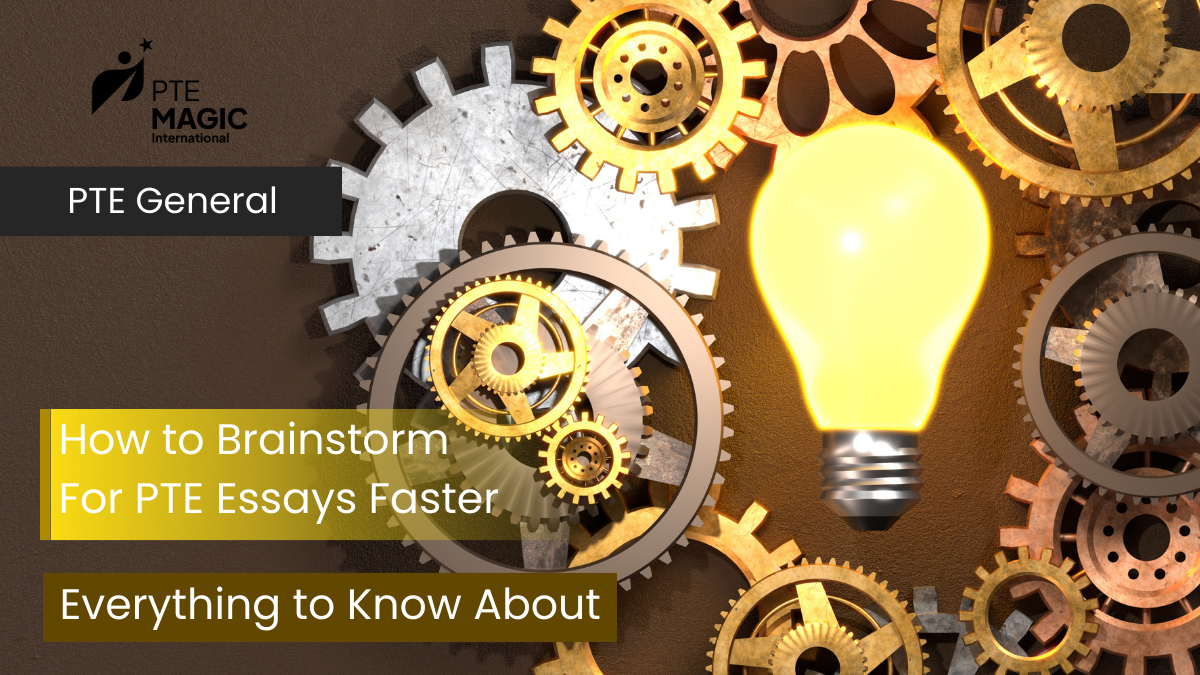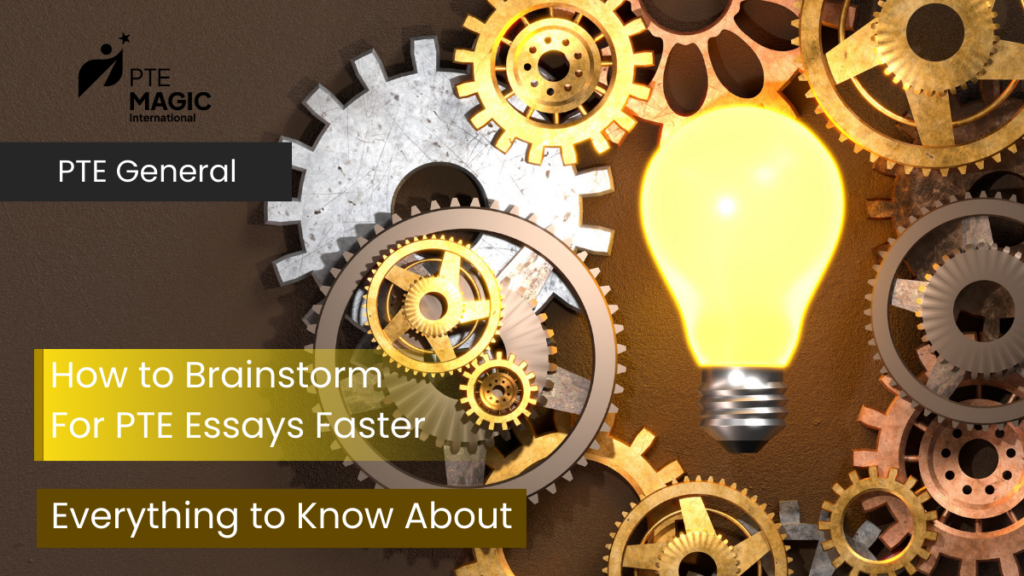Subtotal: $1,350.00
Having no idea how to write an essay is a common problem that many people cope with, especially when taking academic tests like PTE. It can significantly affect the test’s result.
Crafting a well-structured and compelling essay requires not only proficiency in English but also the ability to generate and organize ideas effectively.
In this blog, PTE Magic will provide a step-by-step guideline to brainstorm ideas and offer some tips to do it effectively.
Keep reading to explore the details!
Key Takeaways
- Not knowing how to write an essay can significantly affect your PTE test result.
- Crafting a well-structured and compelling essay requires proficiency in English and the ability to generate and organize ideas effectively.
- PTE Magic provides a step-by-step guideline for brainstorming ideas and offers effective tips.
Related:
3 steps to brainstorm ideas

Step 1: Prepare
The first step in an effective brainstorming session is preparation. It means that you should prepare all the necessary to brainstorm effectively, including external factors and internal factors.
External factors are which belong to the surrounding physical environment. You need to create a conducive environment for creativity. Finding a quiet space, gathering necessary materials such as paper and pens, and eliminating potential distractions would assist you in brainstorming.
About internal factors, ensure that you have a clear understanding of the essay prompt or topic you’re working on. You also need a solid foundation of vocabulary, grammar, and a logical mindset.
Once everything is ready, the brainstorming session will be more productive.
Step 2: Capture the topic and main idea
Once adequately prepared, focus on capturing the essence of the topic and its main idea. It assures you will not be off-topic.
Clearly articulate the central theme or question that your essay aims to address. Then, you can identify the core concept that will guide your brainstorming efforts. Whether it’s a single sentence or a concise statement, capturing the topic and main idea provides a roadmap for your thoughts.
Step 3: Write down all related points
With the topic and main idea in mind, the next step is to write down all related ideas, supporting points, and examples. Don’t filter or critique at this stage; instead, aim for a free flow of ideas. It can help you have more breakthrough thoughts.
This process helps in breaking down mental barriers and encourages a diverse range of thoughts. Whether it’s keywords, phrases, or brief sentences, the goal is to create a comprehensive list of potential elements to include in your essay.
5 tips to brainstorm fast
Freewriting
One of the most powerful techniques to kick off your essay brainstorming process is freewriting. It means that you can write down all that you think on a blank paper.
Set aside dedicated time, grab a pen and paper, and allow your thoughts to flow freely.
At this time, you can disregard all the other factors such as grammar rules, structure, or word choice. The goal is to write down the main ideas and supporting points as much as possible. It is extremely crucial in academic tests when you have limited time to write an essay.
It can be hard and take time at first. But gradually, your brain can get familiar with this flow. Then, you can generate more and more creative but logical ideas at a higher speed.
Freewriting serves as a valuable technique, unlocking the door to a bunch of thoughts that can be refined and channeled into a cohesive essay structure.
Mapping
Mapping or mind mapping is a technique that can help you visualize your idea. By that, you can easily remember.
You can start with the central theme of your essay and branch out into related concepts, subtopics, and supporting ideas.
This visual representation not only aids in organizing your thoughts but also illuminates the connections between different elements. You can build all the ideas more logically.
Mind mapping provides a holistic view of your essay’s potential structure, allowing you to see the relationships between ideas and facilitating a smoother transition from brainstorming to actual writing.
Questioning
It sounds strange but useful in fact. Questioning means that you need to put some questions related to the topic, which can exploit every aspect of the essay prompt.
Consider the underlying issues, the various perspectives on the topic, and how they connect to broader themes or concepts.
Questions act as a supportive addition to critical thinking, prompting you to explore different facets of the subject. You can write an essay that is more persuasive and logical. This plays a vital part in academic tests.
By systematically answering these questions, you not only deepen your understanding but also uncover layers of insights that can elevate the depth and complexity of your essay.
Build a word bank
The word bank is a list of vocabulary words that are suitable to apply in academic tests. It can assist your writing tasks significantly.
Not all vocabulary can apply to academic tests. It requires a higher level of words which are formal and advanced. Therefore, it is better if you have personal resources to use.
You can divide your vocabulary range into small groups. Each of them corresponds with a topic. Every time coping with a particular topic, you can select words from that resource to write.
From that, you will spend less time thinking about what words to choose for the writing. You also can brainstorm faster.
Practicing
Above are some practical tips to brainstorm more effectively. However, all of them are meaningless without practice.
The more you encounter with writing essays and brainstorming, the more mature you are.
In addition, don’t forget to take time to review and learn from experience, then gradually improve.
The brainstorming process doesn’t end with the initial wave of ideas. Take the time to step back, reflect on your brainstorming output, and conduct a thorough review. Identify redundancies, weak arguments, or areas requiring further development. Use this critical evaluation to refine and expand your ideas.
Iterate on your initial brainstorming session, incorporating new insights and perspectives gained through reflection.
This iterative approach ensures that your essay ideas evolve, becoming more refined and nuanced with each round of review, setting the stage for a well-crafted and compelling final piece.
Conclusion
Above are some sharing of PTE Magic that can be helpful for your brainstorming process. By following these three steps and implementing these five tips, you can transform your brainstorming sessions into fertile grounds for original and impactful ideas.
By incorporating these tips into your PTE writing preparation, you’ll not only enhance your idea-generation skills but also build the confidence needed to tackle the writing section. However, remember that practice is the key to mastery, so dedicate time to regular practice sessions to refine and solidify your skills.
Last updated on 17/07/2024

My name is Moni, and I am a seasoned PTE teacher with over 6 years of experience. I have helped thousands of students overcome their struggles and achieve their desired scores. My passion for teaching and dedication to my student’s success drives me to continually improve my teaching methods and provide the best possible support. Join me on this journey toward PTE success!

 Extensive 1 on 1
Extensive 1 on 1 















I am a firm believer that the best teachers educate with their hearts not just their minds.
Moni | PTE MAGIC International Founder
Explore PTE
Tips & Tricks
Recently, a rumour about PTE getting banned in Australia has risen among students and immigrants....
Read more →Most people find getting skilled visas complicated. To complete this process, you should know about...
Read more →Are you wondering why PTE does not give full feedback on your exam? This blog...
Read more →